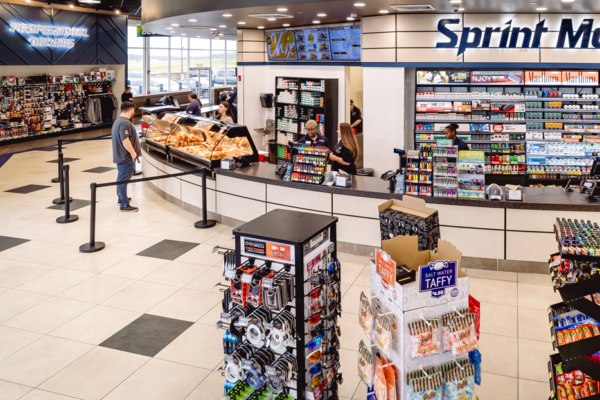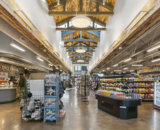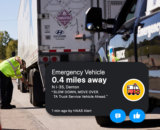Article created for the January digital issue of
Professional drivers are pressed for time, and their need for speed is impacting their buying decisions. From the moment a customer walks in the store, they’re making purchasing decisions, and 81% of drivers told NATSO that they’d gone inside a travel center but left without purchasing food or beverages in the past month. Lines and wait times ranked among the top reasons why, and most drivers said they would be inclined to leave without making a purchase if they saw an average of five people in line.
That 81% represents foot traffic that is already inside the store just waiting to be converted into buyers, which means they represent a significant sales opportunity if operators can remove the bottlenecks that keep them from making a purchase.
“If we lay stores out to make the customer experience, the speed of service and the ability to buy something easy, we will see higher conversion rates,” said Darren Schulte, vice president of membership for NATSO.
Reducing Friction at Checkout
Locations are increasingly turning to technology to increase and diversify checkout options, which a significant percentage of respondents to NATSO’s survey say they are open to using. (Access the survey information in Opportunities Abound at Travel Centers to Serve Professional Drivers and Grow Wallet Share Toolkit here.)
Schulte said NATSO members with self-checkout report that 15% to 30% of their customers are using it. Even moving just some customers out of a line can improve the transaction time for those who prefer to interact with a cashier.
“More and more you’re at a loss if you don’t offer self-checkout,” said Peter Rasmussen, CEO and founder of Convenience and Energy Advisors. “I don’t think you should force somebody into one or the other, but customers want choice.”
Rasmussen added that in most cases, operators can get a return on investment on self-checkout technology in under a year.
When visiting locations that have cashiers and cashier-less options, such as ordering kiosks, self-checkouts, vending machines and in-app ordering, 7% said they always choose the cashier-less option and 20% said they sometimes choose it.
The way self-checkout is positioned can help direct people to the option. Rasmussen said setting up stores so customers have to pass the self-checkout to get to a cashier can make the option more enticing.
The other key is to ensure self-checkouts are easy to use, which doesn’t always happen. “There are a lot of places where the self-checkout is not a seamless experience. You can buy some things but not other things. If that is a customer’s experience, you’d of course say no,” Schulte said.
If a customer wants to buy cigarettes but can’t do it through an automated checkout, they’re more likely to go to a cashier. However, Rasmussen said new technology is making it easier to sell certain items, such as lottery or cigarettes, at a self-checkout. “With some of them, if I’m a cashier and you say, ‘Can I get a pack of Marlboro’s?’ I can card you, request ID or on my remote attendant, I can use a handheld, approve it and bring it over,” he said.
In addition to helping shorten lines, automation offers potential operational benefits, including labor savings. “The labor market isn’t going to return to what it was,” Rasmussen said, adding that automation can make employees’ jobs easier. “If you’ve cashiered for eight hours, you know it is hard. A few people are mean.”
Like self-checkouts, kiosk ordering can be a powerful tool to boost sales, reduce lines at cashiers and increase transaction size. “There is a substantial amount of growth or savings when people can scroll through and upsell,” he said.
For example, digital kiosks have become the highest margin channel for Shake Shack. When guests order via the kiosk, the check tends to be higher as orders are more likely to include limited-time offers, add-ons and a beverage, according to Katie Fogertey, chief financial officer for Shake Shack.
Offering More Options
Drivers said that the amount of time it takes to fuel influences whether they take the time to make a purchase inside the location. The ability for professional drivers to pay at the pump is another way to help drivers get in and out sooner. “The vast majority of travel centers that talk with me tell me they’re seeing a significant increase at pay at the pump at the diesel islands compared to years past,” Schulte said.
He added that truck stops should be looking for ways to make professional driver fueling times and turn them into productive stationary time, such as allowing the drivers to order food or merchandise while they are fueling. Employees could either deliver it to the driver or creating a pickup area for professional drivers to grab their pre-ordered food and merchandise inside.
“We have members that have simply installed a phone that is connected to the food service area so drivers can order food ahead of time and simple pay and go without having to wait in lines,” Schulte said.
Rasmussen said another option is adding a QR code at the pump so drivers could order via their phones. “Any way you can start the experience in advance can improve service,” he said, adding that the next chapter for many locations is offering the ability to order ahead either through an app, an order aggregator or at the pump. “People want to have that choice.
Ensuring Service
While speed is important, the survey found that it shouldn’t come at the expense of personal interaction. Two-thirds of respondents said that both speed of service and personal interaction with staff are important when shopping inside a travel center.
“That personal interaction can come from other areas. It can be throughout the store or from food service,” Rasmussen said. “You can say, ‘I’m going to give personal interaction at the cashier,’ but if I have to stand behind someone who wants to have a conversation and I’m in a hurry, that isn’t a good interaction.”
Again, choice is important. “You might want the personal interaction while I want the self-checkout,” Rasmussen said.
Want more on this?
- What Innovative Retail Technology Should Travel Centers Embrace Now?
- NATSO Connect Education Highlights Strategies to Increase Wallet Share and Boost Profitability
- Opportunities Abound at Travel Centers to Serve Professional Drivers and Grow Wallet Share Toolkit
// This article was created for Stop Watch magazine, the magazine of the NATSO Foundation. The NATSO Foundation is the research, education and public outreach subsidiary of NATSO, Inc. The NATSO Foundation provides programs and products to strengthen travel plazas’ ability to meet the traveling public's needs through improved operational performance and business planning. Visit www.natsofoundation.org for more information. (Donate to the NATSO Foundation here.)
Subscribe to Updates
NATSO provides a breadth of information created to strengthen travel plazas’ ability to meet the needs of the travelling public in an age of disruption. This includes knowledge filled blog posts, articles and publications. If you would like to receive a digest of blog post and articles directly in your inbox, please provide your name, email and the frequency of the updates you want to receive the email digest.





